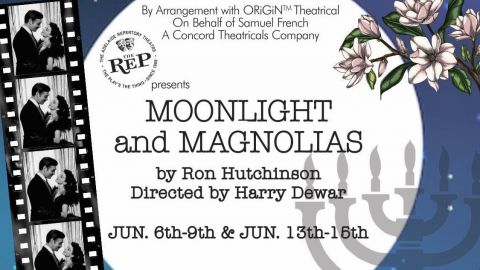Swinging From The Chandelier…
The house full signs have gone up, but not all community theatre productions of The Phantom of the Opera have gone without a hitch. Sally Alrich-Smythe took time out of a Phantom rehearsal to peer behind the mask.
“Don’t even think about auditioning for Christine if you can’t hit the high E.” That statement uttered by a director, embodies for me, the aura surrounding Phantom.
Since opening in 1986, the Cameron Mackintosh production has been a success world-wide, delivering the same big scale, big-budget show that everyone has come to expect.
The professional show is prescriptive in execution and production, cloning itself around the world into a brand that guarantees box office returns. The release of Phantom to the amateur circuit is a wonderful chance to see how the show be re-imagined and played with.
Most societies so far, however, have felt the pressure to stick to the ‘epic’ experience. This is an issue inherent in both the script (there’s no escaping that tricky chandelier) and the attributions of the Cameron Mackintosh production.
I spoke to a number of amateur society presidents and directors to gauge just how successfully this difficult show has translated onto the amateur circuit. Peter Novakovich is currently preparing to produce the show in a small theatre in Campbelltown in western Sydney. Already, he says, the expectations are overwhelming.

“Everyone I speak with about this show always asks the same question, “How are you doing the chandelier?” I’m tempted to have a chandelier sitting on stage for two hours while the cast goes to the pub and just let the audience watch that….”
He has a point. Much of the focus of The Phantom of the Opera is centred on the props and the pyro (its wow factor). It’s certainly the first thing that enters my head when I hear that another society is putting on the show: ‘How will they be able to pull off the chandelier? The boat? The organ? The costumes? Amongst all this, we forget the show has anything else going for it.
“It seems modern audiences are fixated on the effects and the props. Why bother with a performer? Luckily in our tiny shoebox of a theatre we’re forced to think outside the square, which makes us bring out a show’s true nature, and helps us avoid copy-cat directing,” he said.
In fact it appears counter-productive to attempt to emulate the original grandeur of the chandelier as any comparison to the original is just about impossible and laden with potential disappointment.
So, can a production of The Phantom of the Opera that entertains and impresses be produced on a limited budget? My mind flies straight to the Arcadians Theatre Group in Wollongong south of Sydney, who decided to use POTO as an “epic” celebration of the company’s 50th year.
It had its wobbly moments. The night I was in the audience happened to be the night that the stage-crew failed to tell their phantom, Kyle Nozza, that the boat would be travelling a little wider than usual, and he abruptly pulled the brakes on for fear of landing in the orchestra pit. The disruption did not go unnoticed.

Liza Allen, the Arcadians president, tells me “the show's famous chandelier provided an interesting challenge, and the Musical Director did an amazing job to hold still every time it dropped as it was just over the orchestra pit, right near his head (excellent fortitude on his part).”
There were gentle reminders that the production was indeed an amateur one. That doesn’t mean there was nothing to love. The cast was spectacular; a true showcase of triple-threat talents. Tears were shed, goose-bumps bumped and standing ovations had. Liza tells me, their Phantom transferred wonderfully to amateur theatre.
The company owns The Miner’s Lamp Theatre, a 148 seat venue with a “sizeable stage” in Corrimal NSW, but it was not able to accommodate the orchestra size or the set heights. The solution was the Illawarra Performing Arts Centre, a venue with 500 seating capacity.
“The scale of the production was daunting, and provided some anxious times for the Arcadians Board, charged with managing the finances of the group. We were very mindful of the implications if our version of Phantom wasn't an outstanding success; owning a theatre brings an additional financial burden and we simply could not afford to return a loss.”

They were, however, “overjoyed” when they were able to put out the ‘house full’ sign for the season.
Financially the show presents a challenge for any amateur theatre group. Even Neil Gooding’s big-budget company Packemin Productions in Parramatta (western Sydney) has felt the weight of this show-specific expense as it prepares to present Phantom in February 2015 where I am a member of the ensemble.
Transfer expenses are considerable as hardware is sourced from all over the country. A large chunk is coming from CLOC, in Melbourne, which last year put on an extremely successful Phantom.
Costumes must be nothing short of extravagant so the cost is inevitably substantial. According to Neil the costume-hire has been pivotal to the budgeting in comparison with other shows they’ve produced in the past: “For Annie we could just put kids in rags and spend virtually nothing. Phantom is a whole different story”. It doesn’t end here. Royalty costs are slightly higher than other shows, and then there’s the additional cost of a 26 piece orchestra instead of the usual 14-16 piece.
In contrast to the Arcadians, whose orchestra took part purely out of “community spirit” it is usual for the players to be paid. Then there’s the big stuff. Says Neil, “Currently, the chandelier is the biggest budget consideration." There is, apparently, a “simple” chandelier option, albeit with a more complex mechanism, currently under consideration. “We know our preference,” he says, “but it really does come down to the finances.”
Despite the exceptional expense, Liza Allen assured me the Arcadian Theatre Group managed to make a modest profit, “…not an earth-shattering amount compared to the income from the home theatre, and with a substantial amount of extra effort and risk”. Similarly, with early ticket sales healthy for a production next February, and a fabulous reputation to help them along, Packemin Productions are quietly confident they won't be out of pocket.
Sitting in the hall at information night for the Strathfield Musical Society, I scanned the crowd, conscious of only one thing … who were the Christines and the Phantoms? As Peter Novakovich said, “… everybody wants to play either the Phantom or Christine. You'd think it was only a two-person show.”

They are, however, the dream roles for many performers. The swelling in numbers of audition attendees is testimony to the popularity of these two roles. For several amateur societies the scheduling of audition and call back sessions to accommodate the increased number of Christine and Phantom hopefuls occurred over several nights rather than the usual one or two.
I spoke to one aspiring Christine who, being relatively tall, contacted all the tall tenors she could think of to bully them into auditioning for the role of Raoul in order to boost her chances.
In South Australia, The Whyalla Players production of The Phantom of the Opera selected two ‘new-comers’ for the two highly demanding lead roles. Ron Hay, the show’s producer, left behind his rock n’ roll roots to play the role of the Phantom. The role of Christine was shared between 17-year-old Imala Konyn, and 16-year-old Kaitlyn McKenzie, two very young voices for a presence and range demanded by ‘Christine’.
Such decisions could only ever be made in amateur theatre and, however risky, leave room for a lot of exciting exploration and discovery. Perhaps most notably, The Whyalla Players formed a collaboration with the State Opera Company of South Australia, who didn’t directly interfere with the locals' production, but offered assistance and singing-direction where they could, also providing players to fill spaces in the orchestra.
In the case of Packemin Productions, the role of Christine was released at the last minute to open auditions. “I was confident we’d find the leads we needed. We did and we’re very happy with our Phantom and Christine (Ben Mingay and Erin Clare). It was actually roles outside of these two that preoccupied my head during the auditions,” Neil Gooding says.
He is talking specifically about Carlotta and Piangi, the show’s token opera voices, and the roles of Firmin and Andre. In the case of the former two, particularly Carlotta, it is difficult to find a singer technically capable of performing such material night after night through the open audition process. There’s hitting the notes and then there’s technique.
 Firmin and Andre are big acting roles and require strong singers. Neil, aware of the plague, common to community theatre - ‘where are all the men?’- confessed that he was nervous about being able to find older men with refined enough skill for these roles.
Firmin and Andre are big acting roles and require strong singers. Neil, aware of the plague, common to community theatre - ‘where are all the men?’- confessed that he was nervous about being able to find older men with refined enough skill for these roles.
The decision, in the end, was that talent trumped the traditional stereotypes of the role; Packemin’s Phantom has a tall, slim Carlotta, Johanna Allen, a trained classical vocalist rather than the plump opera diva we’ve come to expect, and a youthful Firmin, tenor Gavin Brightwell.
High hopes are held for the capabilities of Packemin who, without pretending to be at the same level as a professional production, have a budget substantially larger than other theatre groups in the state. When the rights were first released Neil Gooding was too afraid to touch the show; “people want to see what they remember from the professional show” which is simply impossible to achieve without millions to spend, and so he was “…sceptical that non-professional companies could satisfy audiences on their given budgets.”
When I asked him what changed his mind, he said simply, “CLOC. What CLOC achieved was nothing short of a miracle.” Undeniably, excellent talent aside, the success for CLOC largely lay in the budget available to produce the wow-factor.
Having been entertained by a number of lower-budget, fully amateur POTO productions this year around the Sydney circuit, I have no doubt that Phantom can be produced well by any company possessing the dream. However, these companies shouldn’t be afraid of giving the show a new image, of wowing their audiences by successfully utilising the strengths and resources available at a community level. For this reason, I look forward to Peter Novacovich’s experimental production next year, which will not even touch a fly-tower.
“What about the chandelier?” I teased.
“I guess you’ll just have to see our show.”
Images (from top): Willoughby Theatre Company (Perfect Images Photography); CLOC; Miranda Musical Society (Grant Leslie, Perfect Images); Savoyards; Ben Mingay - Packemin.
Community Theatre Seasons 2015
More Community Theatre Reading
Originally published in the January / February 2015 edition of Stage Whispers
Subscribe to our E-Newsletter, buy our latest print edition or find a Performing Arts book at Book Nook.








